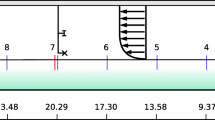Abstract
The variations of drag force acting on the windbreak and the bulk drag coefficients for different windbreak widths were studied experimentally in the Eiffel-type non-circulating wind tunnel at the Hydraulic Engineering Laboratory, Saitama University, Japan, to elucidate the effects of windbreak width in the wind direction on wind velocity reduction behind a windbreak. The variations of flow field for different windbreak widths were studied numerically by using the two-dimensional Reynolds-averaged Navier-Stokes (RANS) equation with a k-ε turbulence closure model. Results show that the total drag force to wind increased with increasing windbreak width, but the bulk drag coefficient decreased slightly. The relationship between the bulk drag coefficient C d and the windbreak width W and height H can be presented by the equation of C d =k d (W/H)−b (k d , b: constants). The result of the numerical simulation shows that the windbreak width greatly affects the location and the value of the minimum wind velocity. The wind velocity decreased by 15%–22% as the windbreak width increased.
Similar content being viewed by others
References
Bagnold RA. 1973. The Physics of Blown Sand and Desert Dunes, 4th Edition. London: Chapman & Hall.
Bradley EF, Mulhearn PJ. 1983. Development of velocity and shear stress distribution in the wake of a porous shelter fence. J Wind Eng Ind Aerodyn, 15: 145–156.
Cornelis WM, Gabrieis D. 2005. Optimal windbreak design for wind-erosion control. J Arid Environments, 61: 315–332.
Guan DX, Zhang YS, Zhu TY. 2003. A wind-tunnel study of windbreak drag. Agricultural and Forest Meteorology, 118: 75–84.
Guyot G. 1978. Determination des efforts exerces par le vent sur un brise-vent. Boundary-Layer Meteorology, 15: 57–67.
Hagen LJ, Skidmore EL, Miller PL, Kipp JE. 1981. Simulation of effect of wind barriers on airflow. Trans ASAE, 24: 1002–1008.
Heisler GM, DeWalle DR. 1988. Effects of windbreak structure on wind flow. Agriculture Ecosystems and Environment, 22–23: 41–69.
Jenson M. 1958. The model law for phenomena in the natural wind. Ingeniören, 2: 121–128.
Launder BE, Spalding DB. 1974. The numerical computation of turbulent flow. Computational Methods in Applied Mechanical Engineering, 3: 269–289.
Moysey EB, McPherson FB. 1966. Effect of porosity on performance of windbreaks. Trans ASAE, 9: 74–76.
Nepf HM. 1999. Drag, turbulence, and diffusion in flow through emergent vegetation. Water Resources Research, 35(2): 479–489.
Perera MDAS. 1981. Shelter behind two-dimensional solid and porous fences. J Wind Eng Ind Aerodyn, 8: 93–104.
Raine JK, Stevenson DC. 1977. Wind protection by model fence in a simulated atmospheric boundary layer. J Ind Aerodyn, 2: 159–180.
Seginer IDO. 1972. Windbreak drag calculated from the horizontal velocity field. Boundary-Layer Meteorology, 3: 87–97.
Wang H, Takle ES. 1995. A numerical simulation of boundary-layer flows near shelterbelts. Boundary-Layer Meteorology, 75: 141–173.
Wang H, Takle ES. 1996. On three-dimensionality of shelterbelt structure and its influences on shelter effects. Boundary-Layer Meteorology, 79: 83–105.
Wilson JD. 1985. Numerical studies of flow through a windbreak. J Wind Eng Ind Aerodyn, 21: 119–154.
Wilson JD. 1987. On the choice of a windbreak porosity profile. Boundary-Layer Meteorology, 38: 37–49.
Woodruff NP, Fryrear DW, Lyles L. 1963. Engineering simulation and momentum transfer principles applied to shelterbelt studies. Trans ASAE, 6(1): 41–47.
Author information
Authors and Affiliations
Corresponding author
Rights and permissions
About this article
Cite this article
Yusaiyin, M., Tanaka, N. Effects of windbreak width in wind direction on wind velocity reduction. Journal of Forestry Research 20, 199–204 (2009). https://doi.org/10.1007/s11676-009-0039-6
Received:
Accepted:
Published:
Issue Date:
DOI: https://doi.org/10.1007/s11676-009-0039-6




